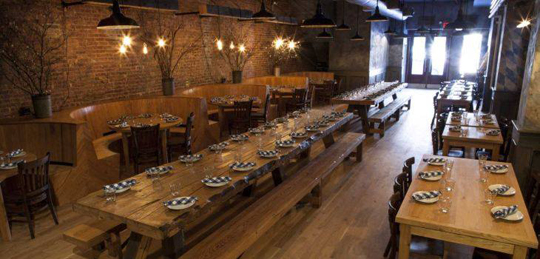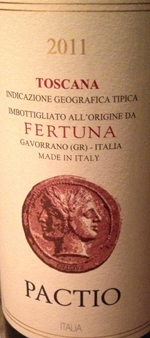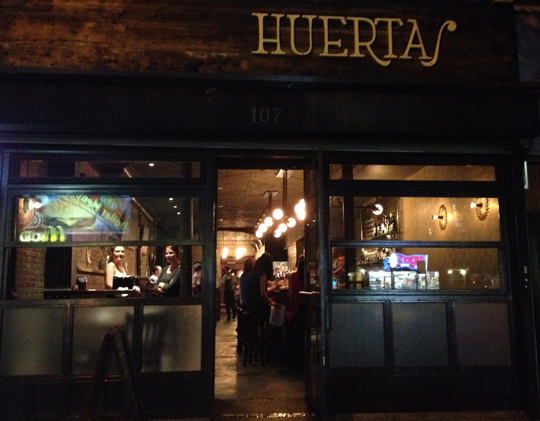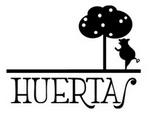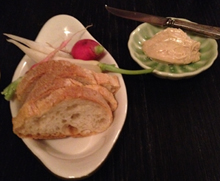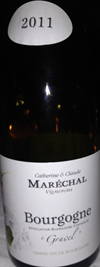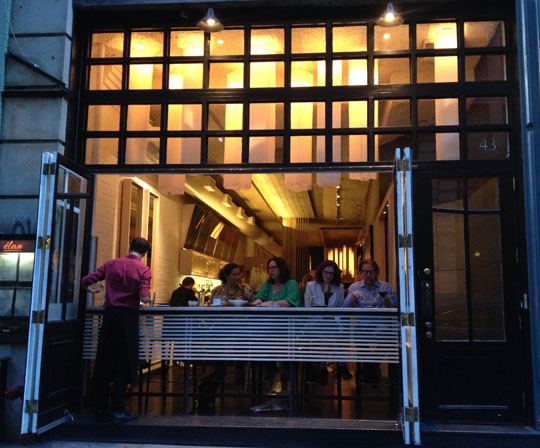
Note: Elan closed in February 2016. The restaurant was in a high-rent neighborhood, and it never really caught on.
*
 For David Waltuck, it has been a long walk in the desert. His beloved Chanterelle, once a four-star restaurant, closed abruptly in 2009, in the depths of the Great Recession. Who’d have thunk he’d spend the next five years on forgettable consulting projects, before finally opening his own place again?
For David Waltuck, it has been a long walk in the desert. His beloved Chanterelle, once a four-star restaurant, closed abruptly in 2009, in the depths of the Great Recession. Who’d have thunk he’d spend the next five years on forgettable consulting projects, before finally opening his own place again?
His new restaurant, élan, is a double palimpsest, with echoes not just of Chanterelle, but also Veritas, the last restaurant in this space, also felled by the financial crisis. Give Waltuck at least this much credit: he closed Chanterelle with his reputation intact, instead of spoiling what he’d achieved with a failed re-vamp, as the Veritas owners did.
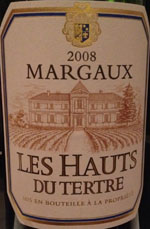 If you remember Chanterelle at its best, it’s hard not to be melancholy that such a wonderful place can no longer exist. But its charms came at a price: $95 prix fixe, and that was in 2006, the last time I visited. You needed an occasion to go there. Heaven knows what it would be today for comparable quality—certainly not the kind of restaurant where you could just pop in for a quick bite after work.
If you remember Chanterelle at its best, it’s hard not to be melancholy that such a wonderful place can no longer exist. But its charms came at a price: $95 prix fixe, and that was in 2006, the last time I visited. You needed an occasion to go there. Heaven knows what it would be today for comparable quality—certainly not the kind of restaurant where you could just pop in for a quick bite after work.
At élan, there’s no amuse bouche or petits fours, no cheese cart or service brigade. But you could drop in a couple of nights a week without breaking the bank. The cuisine is ambitious for the price, carefully prepared, and like no other in town. Waltuck’s French technique borrows liberally from Asia (“General Tso”), Greece (moussaka), and middle Europe (sauerkraut). Some items are just unclassifiable (foie gras lollipops). Starters and appetizers are mostly in the $14–19 range, main courses $27–33, side dishes $8.
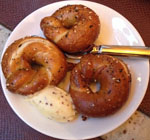 If you hoped the owners bought out the Veritas wine list, you’ll be disappointed. The list here runs to about 100 bottles, with no particular viewpoint, most of them priced eccentrically at $20 increments: $45, $65, $85, $105,etc. Among the reds, $65 seems to be the sweet spot, but in the ten days since we visited, the 2008 Margaux we tried has apparently been replaced (on the online list) by the 2010 at the same price.
If you hoped the owners bought out the Veritas wine list, you’ll be disappointed. The list here runs to about 100 bottles, with no particular viewpoint, most of them priced eccentrically at $20 increments: $45, $65, $85, $105,etc. Among the reds, $65 seems to be the sweet spot, but in the ten days since we visited, the 2008 Margaux we tried has apparently been replaced (on the online list) by the 2010 at the same price.
The bread service (above right) consists of warm, house-made “everything” pretzels with mustard butter. Finish them, and the server brings more. They’re so good, you might be tempted to skip dinner, and just eat these.


Waltuck’s guacamole ($16; above left) is like no one else’s, topped sea urchin. The seafood sausage was perhaps Chanterelle’s best dish, and the version served here ($18; above right) is every bit as good as I remember.
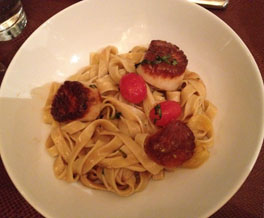

Duck fat appears in multiple dishes, here with fettucine and grilled scallops ($15 the small portion shown, above left). Salmon is usually the most boring dish on any menu, but Waltuck makes this version exciting, with tamarind spices and a crisp skin ($30; above right).
The space has been totally remodeled, with no remaining vestiges of the last, failed re-design at Veritas. There’s now a dining counter at the front window, where we sat (see photo at the top of the post). This is a comfortable place to perch on a warm evening, but random passersby may walk up to you, and chat you up while you’re eating.
As we had our backs to the dining room, I didn’t get a feel for how full it was, but in its opening couple of months, the restaurant has been solidly booked at prime times. Service was in line with comparable upper mid-range establishments.
For those who missed Chanterelle, David Waltuck’s return has been a long time coming. Welcome back!
élan (43 E. 20th St. between Broadway & Park Avenue South, Flatiron District)
Food: French technique; American chef; global influences
Service: Just fine
Ambiance: Upscale casual
Rating: ★★
 Tuesday, October 14, 2014 at 05:33AM
Tuesday, October 14, 2014 at 05:33AM 
Marco Moreira and Jo-Ann Makovitzky, the husband-and-wife restaurateurs, have not exactly rushed to expand. After opening the upscale French restaurant Tocqueville in 2000, they waited seven years to move it down the street, so they could launch the Michelin starred sushi den 15 East in its former dining room.
 That was it for another six years, until they opened The Fourth, an all-day American brasserie in the new Hyatt Union Square, which landed with a thud. The critics mostly ignored it, and that may have been an act of kindness. Reviewing for the Daily News, Michael Kaminer said the restaurant felt like it belonged in an airport: “everything feels vetted by committee, from office-suite décor to a meek menu with just enough Food Network flourishes to excite out-of-towners.”
That was it for another six years, until they opened The Fourth, an all-day American brasserie in the new Hyatt Union Square, which landed with a thud. The critics mostly ignored it, and that may have been an act of kindness. Reviewing for the Daily News, Michael Kaminer said the restaurant felt like it belonged in an airport: “everything feels vetted by committee, from office-suite décor to a meek menu with just enough Food Network flourishes to excite out-of-towners.”

